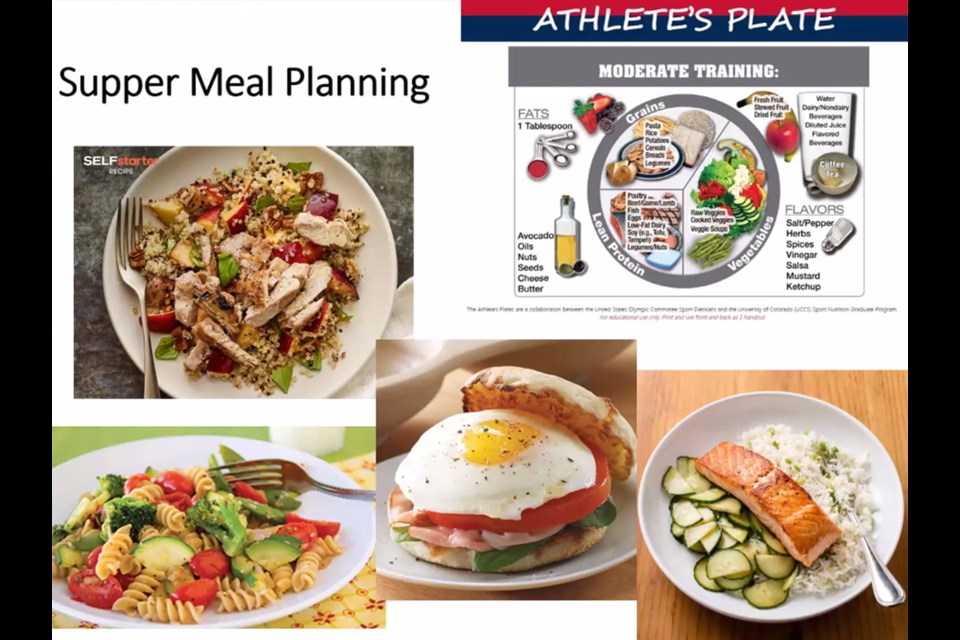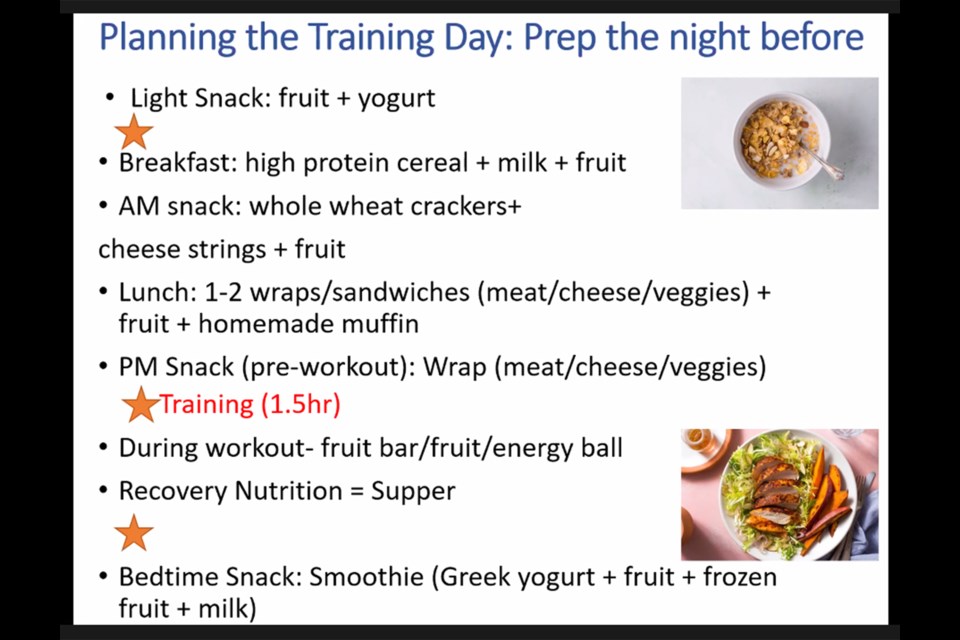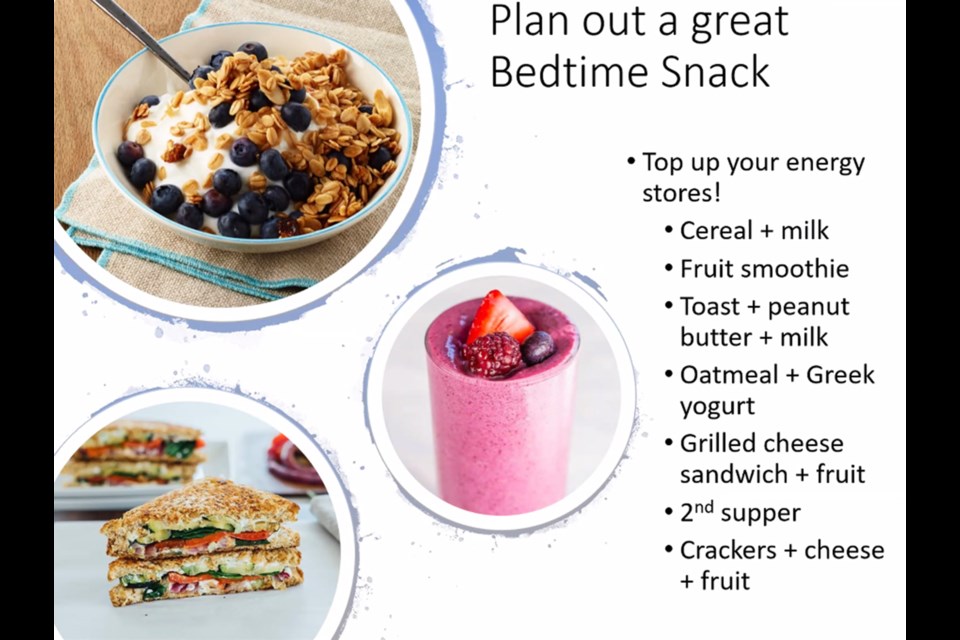To say things have changed over the years is a bit of an understatement.
It was with that in mind that the Districts for Culture, Recreation and Sport held their most recent seminar, with sports dietician Heather Hynes of the Sport Medicine and Science Council of Saskatchewan offering tips and information for proper fuelling for training.
“Where it really starts is getting a clear understanding of a training diet or how we’re managing someone’s overall physical performance, and it comes down to ensuring and helping an athlete get in enough energy on a daily basis,” Hynes said.
“That intake, the energy their body is getting from foods, is really a foundational piece… we really have to focus on how often we want to be giving our bodies food, what types of foods we should be eating as often as possible, trying to have a balance in variety of foods and the kind of hydration we should have in place.”
Eat Early, Eat Well
It begins with what you do right off bat, first thing in the morning. That could involve a full, healthy breakfast including oatmeal and fruit, yogurt with berries and a banana or even homemade blueberry pancakes. Anything healthy to get fuel into the system, and especially first thing, regardless of whether you like breakfast
“Training the gut and the stomach to accept food in the morning is a skill, and it’s a real important skill for athletes to develop early in their career because you’ll always come across competitions that are held early,” Hynes explained. “I frequently come across athletes who say they can’t eat in the morning, and their strategy is not to eat, and that’s not really a strategy. So start small with a mini-meal before a training session if need be… and build toward it becoming a complete meal.”
Eat Smaller Meals More Often
Steady intake throughout the day is also important to avoid the high and low energy levels that come through the usual ‘three meals a day’, which often feature three hours or more between eating.
“When we go longer than three hours without eating, that’s when we start to crave foods, foods like carbohydrates like breads, cereals, crackers and fruits, our body knows that’s going to result in a higher spike in blood sugar,” Hynes explained. Avoiding those cravings and that spike can be accomplished by smaller meals throughout the day -- breakfast at 9 a.m., lunch at 12 p.m., healthy snack at 3 p.m., dinner at 6 p.m. and a bedtime snack at 9 p.m.
The importance of balanced nutrition throughout the day can been seen in an athlete showing up for a 5 p.m. practice without having taken in anything since lunch.
“If they had a lunch that wasn’t as sufficient, but they’re used to having their big meal being supper, they’ll go into training low on energy,” Hynes said. “That’s what we want to try and switch around, allowing lunch to be more complete and allowing the snack to come in mid-afternoon or after school to help bump up energy for whatever training they might be doing.”
Drink Fluids, Stay Hydrated
Hydration has also become an increased component with proper nutrition, with athletes hydrating throughout the day and throughout exercise.
That translates into two to three litres of water a day as a general estimate, depending on the needs of the body. Hynes pointed out that proper fluid intake during exercise is also a skill that takes adapting to and athletes should learn water intake with a high heart rate early in their training career.
Small Snack If Needed, Balanced Supper
Heading into training before supper might require a slight boost in fuel intake, and Hynes recommends something small, like a ¼ cup of raisins, a medium banana or even a healthy homemade muffin.
“This can really be helpful for that athlete that has to go right from school and into their training session,” Hynes said.
Then there’s the recovery meal, which is often supper for athletes who train after school or work.
Hynes presented a special slide that showed an ‘athletes plate’, featuring the proper ratio of proteins, grains and vegetables. Vegetables take up a little less than half of the plate, with protein and grains covering about a third each. The ratio helps ensure athletes are receiving proper amount of nutrition through a variety of sources, with the nutrient variety helping repair and recovery for hard-worked muscles.
A post-supper training regimen requires a bed-time snack for much the same reasons as above.
“You are supposed to fuel in the evenings and especially if it’s the time of day you’re active,” Hynes said. “The bedtime snack is providing the body with a combination of ingredients and carbohydrates and protein and helping the athlete to recover… if an athlete says they’re sore the next day, that’s really an area I’ll focus in on, are you having snack before you go to bed and getting enough protein at that time?”
All About Protein Intake
Ah, yes, protein. The building block for repairing muscles and increasing size and strength for any athlete. That’s where the aforementioned pre-game steak and eggs came in during the old days, without the realization that the lack of carbohydrates in such a meal wouldn’t help performance, but would aid in recovery.
Typically, a high-performance athlete less than 18 years old needs up to 1.8 grams of protein per kilogram of bodyweight, while older athletes need up to 2.0 grams per kilogram.
Hynes used the example of a 15-year-old female athlete weighing 125 pounds. She’d need about 102 grams of protein a day, broken into 16 to 20 grams per meal -- which can be found in the likes of three eggs, a can of tuna, half cup of cottage cheese, ¾ cup of greek yogurt and so on.
“That is a real important piece of how a body should be getting protein, we want it to be spread out as evenly as possible,” Hynes explained. “That’s very helpful for supporting the development of muscle mass and strength and the health of the individual.”
Supplements Only When Necessary
This all leads to supplementation, which Hynes only recommends in the case of a specific deficiency such as iron, vitamin D or B12. That’s because, in most cases, proper nutrition intake will make protein powders and the like unnecessary.
“I have athletes that are 10, 12-years-old that said ‘I put a scoop of this protein in my smoothie’ and I’m like ‘really? That’s definitely not needed’,” Hynes said. “It is really tempting for athletes to look at supplements as the answer to questions they might have or for simplicity, taking a scoop of something and shaking it and drinking it would be the same as having food.”
Hynes recommends contacting herself at heather.hynes@sasktel.net if there are any questions with regards to supplementation.
Final Takeaways
Overall, Hynes carried seven takeaways from the seminar:
- Have balanced meals with the proper ratio of proteins, vegetables and grains
- Be aware of protein timing and intake
- Fuel for demands of the day
- Schedule snacks to maximize training
- Focus on hydration and be consistent
- Fuel every three to four hours
- Monitor progress to see if things are improving or need to be changed.
The seminar was part of a monthly series from the Districts for Culture, Recreation and Sport, with the next sessions in April featuring a look at sleep and how it affects sports performance.







